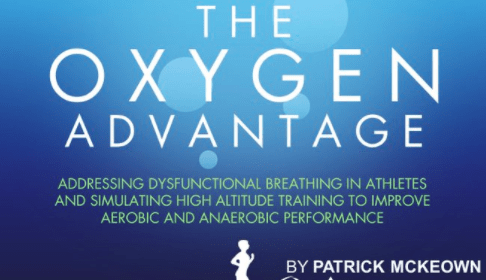
By Patrick McKeown, (2015)
Nasal Breathing
Patrick McKeown, author of the Oxygen Advantage, The Simple, Scientifically Proven Breathing Technique Which Will Revolutionise Your Health And Fitness, transformed his sleep, anxiety and need for asthma medication by addressing his dysfunctional breathing patterns and training himself to become a nasal breather.
He asserts that ‘it’s never too late to correct your breathing; breathlessness, nasal congestion, sleep apnea, stress, anxiety, snoring and improved performance in any aspect of your life be it athletic or otherwise’.
In a recent contribution to the Feel Better, Live More podcast with Dr. Rangan Chattergee, Patrick speaks about his experience as a 26 year old adult, waking up tired every morning with increasing need for asthma medication, when one day he read an article which said ‘ breathe through your nose and breathe lightly’. And this led him on a journey which took him, in 2002, to the Buteyko Clinic in Russia to learn the Buteyko Breathing Method.
He considers mouth breathing to be dysfunctional breathing, characterised by fast and shallow flow. Because of the relationship between our breath and our emotions, (open mouth breathing tends to tap into our fight or flight system whereas nasal, diaphragmatic breathing soothes our nervous system), learning to harness the breath has the potential to subdue our stress response and allow all systems of our body to maintain balance and function as they should.
Restoring nasal breathing during waking hours and during sleep is of critical importance if individuals aspire to live life to their potential. If you wake up consistently with a dry mouth you will most certainly be mouth breathing. This does affect the quality of your deep sleep which in turn affects your concentration, agitating the mind and the functionality of every body system is stressed.
If you are experiencing chronic stress (the World Health Organisation are calling stress the epidemic of the 21st century) this will result in negative breathing patterns which will affect sleep quality and so the cycle goes on.
Nasal breathing which is slow, regular and light (barely perceptible) targets the diaphragm, signalling to our body to relax, but what’s more, the oxygen uptake in both the blood stream and at the level of the cells increases, making it a more efficient and economical way to breathe.
Nasal breathing is recommended not only during restful periods but during physical exertion too. An adaptation to this will be increased aerobic capacity which has implications for athletic performance but also for people with cardio and respiratory difficulties or disease as well as everyone in between.
When we mouth breath during exercise there is 42% greater water loss which inevitably affects our output. So, although when exercising or training you will find initially that your performance will need to be dialled back, in time, with consistent nasal breathing, you will become more efficient.
Measuring Your Bolt Score
The Bolt Score is a measure which can be used to help you work towards optimum breathing.
It is recommended to sit restfully with the mouth closed for 5 minutes prior to trying the ‘technique’. At the completion of an exhalation, the nose is pinched and breathing suspended only for as long as is comfortable and the first strong signal to take an in-breath is experienced. The inhalation which immediately follows the release of the nose should be normal flow and not a gasp! Functional breathing for ALL individuals is considered to be no less than 25 seconds.
Should you score less than 25 seconds, it’s advised to progressively work towards that target, for example if your score is 10 seconds, next time aim for 12 seconds. Allow full recovery of breath before trying again in any one session.
Patrick implores listeners to persevere with efforts to restore nasal breathing for no less than two weeks. When working with his clients he recommends special tape for the mouth, especially for night time. (Clearly any medical nasal obstruction is ruled out).
Another target is to aim for 6 or less nasal ventilations per minute (inhalation and exhalation) while at rest.
Take Homes
In a nutshell, Patrick McKeown invites us to:
Observe our breath and also observe our mind and start to notice the relationship between the two.
Breathe with a slow, light breath using the diaphragm muscle (which means the belly extends outward with the in-breath and moves back in on the out-breath).
Harness the power of the breath to aid performance, resilience and that ‘untapped edge’.
Try it for 2 weeks!

